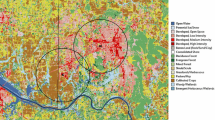Abstract
Lidar measurements of the thickness of the atmospheric entrainment zone are presented. The measurements were obtained in central Illinois during 6 days of clear-air convection.
A new method was developed to monitor the potential temperature jump across the entrainment zone. A single early morning temperature sounding and continuous lidar measurements of the mixed-layer height provide potential temperature jump values which agree well with in situ observations.
Lidar measurements of the thickness of the entrainment zone normalized by mixed-layer depth are presented as a function of a ‘convective’ Richardson number; these values show reasonable agreement with published laboratory results. The lidar observations span a wider range of mixed-layer depths and contain higher values of the normalized entrainment rate (dh/dt)/w * than those observed in tank studies. Both lidar and tank results show that simple parcel theory does not properly predict entrainment-zone thickness. During this experiment which examined mostly high entrainment conditions, the normalized entrainment-layer thickness was linearly dependent on entrainment rate.
Similar content being viewed by others
References
Boers, R., Eloranta, E. W., and Coulter, R. L.: 1984, ‘Lidar Measurements of Boundary Layer Dynamics: Tests of Parametized Models of Mixed-Layer Growth Rate’, J. Clim. Appl. Meteorol. 23, 247–266.
Deardorff, J. W.: 1979, ‘Prediction of Convective Mixed-Layer Entrainment for Realistic Capping Inversion Structure’, J. Atmos. Sci. 36, 424–436.
Deardorff, J. W., Willis, G. E., and Lilly, D. K.: 1969, ‘Laboratory Investigation of Non-Steady Penetrative Convection’, J. Fluid. Mech. 35, 7–31.
Deardorff, J. W., Willis, G. E., and Stockton, B. M.: 1980, ‘Laboratory Studies of the Entrainment of a Convectively Mixed Layer’, J. Fluid Mech. 100, 41–64.
Driedonks, A. G. N.: 1982, ‘Models and Observations of the Growth of the Atmospheric Boundary Layer’, Boundary-Layer Meteorol. 23, 283–306.
Hardy, K. R. and Ottersten, H.: 1969, ‘Radar Investigations of Convective Pattern in the Clear Atmosphere’, J. Atmos. Sci. 26, 666–672.
Kaimal, J. C., Wyngaard, J. C., Haugen, D. A., Coté, D. R., Isumi, Y., Caughey, S. J., and Readings, C.: 1976, ‘Turbulent Structure of the Convective Boundary Layer’, J. Atmos. Sci. 33, 2152–2169.
Konrad, T. G.: 1970, ‘The Dynamics of the Convective Processes in Clear Air as Seen by Radar’, J. Atmos. Sci. 27, 1138–1147.
Kunkel, K. E., Eloranta, E. W., and Shipley, S. T.: 1977, ‘Lidar Observations of the Convective Boundary Layer’, J. Appl. Meteorol. 16, 1306–1311.
Mahrt, L.: 1979, ‘Penetrative Convection at the Top of a Growing Boundary Layer’, Quart. J. Roy. Meteorol. Soc. 105, 969–985.
Phillips, A. M.: 1972, ‘The Entrainment Interface’, J. Fluid. Mech. 51, 97–118.
Raymond, E. and Readings, C. J.: 1974, ‘A Case Study of the Structure and Energetics of an Inversion’, Quart. J. Roy. Meteorol. Soc. 100, 221–223.
Sroga, J. T., Eloranta, E. W., and Barber, T.: 1980, ‘Lidar Measurements of Wind Velocity Profiles in the Boundary Layer’, J. Appl. Meteorol. 19, 598–605.
Stull, R. B.: 1973, ‘Inversion Rise Model Based on Penetrative Convection’, J. Atmos. Sci. 30, 1092–1099.
Stull, R. B.: 1976, ‘Mixed-Layer Depth Model Based on Turbulent Energetics’, J. Atmos. Sci. 33, 1268–1278.
Tennekes, H.: 1973, ‘A Model for the Dynamics of the Inversion Above a Convective Boundary Layer’, J. Atmos. Sci. 30, 558–567.
Zeman, O. and Tennekes, H.: 1977, ‘Parameterization of the Turbulent Energy Budget at the Top of the Daytime Atmospheric Boundary Layer’, J. Atmos. Sci. 34, 111–123.
Author information
Authors and Affiliations
Rights and permissions
About this article
Cite this article
Boers, R., Eloranta, E.W. Lidar measurements of the atmospheric entrainment zone and the potential temperature jump across the top of the mixed layer. Boundary-Layer Meteorol 34, 357–375 (1986). https://doi.org/10.1007/BF00120988
Revised:
Issue Date:
DOI: https://doi.org/10.1007/BF00120988




